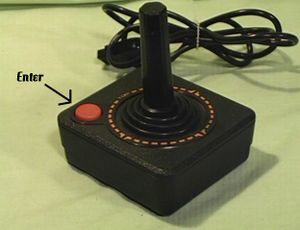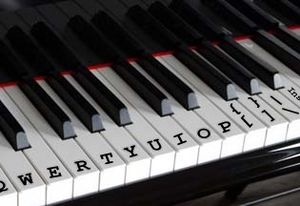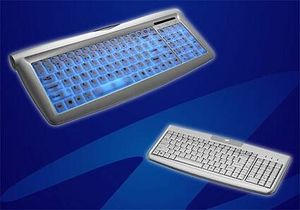Input devices
Input devices are the most important components to a computer. Without input devices, people would have no way of communicating with computers. Without input devices, this website would not exist. Without input devices, nobody would be able to compile a list of input devices. Without input devices, you wouldn't be reading this article and your whole life would be a waste. We should study input devices to learn why we should appreciate them so much. We should use input devices to scroll down this page.
Joystick[edit | edit source]
The joystick was the very first input device designed for the computer. This device was built by IBM as a companion piece to their first prototype computer, the BRAINIAC, which was the size of three olympic stadiums and was capable of adding single-digit numbers together.
The "stick" of the joystick was used to scroll through any number from 1 to 8 (computer memory wasn't expansive enough at the time to count up to 9). The button on the joystick served as a primitive ENTER button, used to confirm the user's number of choice.
Unfortunately, the very first joystick was destroyed in an accident at the IBM research facilities. The prototype computer accidentally fell over during an unreported "incident" and flattened the joystick into a plastic pancake. Forty-five employees, three stray animals, and two police officers were also killed in the disaster.
Later, Atari replicated the joystick for their first unsuccessful home video game system, the Atari 1300. IBM tried to sue Atari for patent infringement, but Atari has denied all knowledge of the IBM prototype.
Classic Keyboard[edit | edit source]
The keyboard is now considered the quintisential input device for a computer. The evolution of the modern keyboard has come a long way since the first classic keyboard was designed.
In the early days of the personal computer, an illiterate pianist was hired by Hewlett-Packard to design a device that could send information to the computer. The result was a machine that resembled a piano, with keys that have been labeled with letters and symbols. Because the pianist did not know the sequence to the alphabet, he slapped letters to random keys, thus marking the early stages of the modern keyboard alphabet.
The most common problem with the classic keyboard was the inconvenience of stretching one arm to the left side of the keyboard and the other arm to the right end of the board just to hit SHIFT + M. Scientists needed to find a way to crunch all of the buttons into one single, incoherent pile.
Modern Keyboard[edit | edit source]
The modern keyboard began as an offshoot of the classic keyboard. While assuming the basic layout of the keys on the classic keyboard, the modern keyboard crunched all of the buttons into one small rectangular base. Also, a few new keys were introduced to the modern keyboard, including:
- ESC
- INSERT
- PAGE DOWN
- G
- RIGHT ARROW
- 9
- NUM LOCK
- >
- F3
- FAST FORWARD (later removed after being deemed useless)
Species[edit | edit source]
- Qwertyto (Qwertic)
- Qwertytus (the standard QWERTY layout)
- Azertytus (the AZERTY layout)
- Qwertzonus (the QWERTZ layout)
- Semiqwertyto (half QWERTY, designed to be more efficient while still being easy for people to switch to)
- Colemaki (the Colemak layout)
- Irreleva (layouts that have almost nothing to do with QWERTY)
- Dvorakus (the Dvorak layout)
Mouse[edit | edit source]
The mouse, fudge one of today's most important input devices, was a product discovered entirely by accident. In the early days of Microsoft operating systems, Macintosh devised a clever campaign against their growing rivals. Macintosh devised a product that was originally known as the Apple Smasher. Whenever a person would buy a new Apple computer from Macintosh, an Apple Smasher would be included for use in breaking into little pieces a previously-owned PC running a buggy version of Microsoft Windows. The product became very popular with young children and old nerds alike.
It wasn't until two years later that Steve Jobs began sliding an Apple Smasher across his desk and suddenly realized the potential in such an object. He designed a prototype computer device based on the design of the Apple Smasher, and it instantly became an important input device.
Several names for this device were considered before the "mouse" was adopted, including:
- Hamster
- Rodent
- Gerbil (Which has since been known for other types of 'input'... see Richard Gere)
- Slidey Thing
- Apple Smasher Deluxe
- Electronic Donut
- Ferrit
Other computer companies have since attempted to develop their own versions of the mouse, but Macintosh would always remain in the lead. Later developments of the mouse would include the Happy Mouse, the Mickey Mouse, and the Mighty Mouse.



